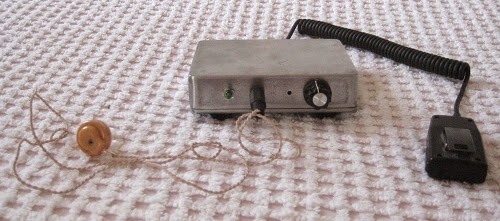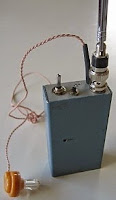Author Archive
 Amateur radio as a gateway to a career in engineering?
Amateur radio as a gateway to a career in engineering?
See http://www.kb6nu.com/is-amateur-radio-still-a-gateway-to-electrical-engineering/ .
At one time, amateur radio was a good gateway into an engineering career, but I have real doubts this is true today. In my younger days, when I started as a professional radio engineer nearly everyone who was any good was a radio amateur. When I left 7 years ago, I was the only person doing any amateur radio building over my lunch break. The magic is no longer there. In fact people are embarrassed to admit they are radio amateurs. We need to find what connects with the younger generation or the future of our hobby is at great risk.
I think I have mentioned on my blog before that when interviewing potential RF design engineers with good honours degrees I was appalled to find that most knew nothing about radio. I knew more as a schoolboy. This is a sad indictment of our times. It was not that I was good (I was not) but the quality of good engineers was not there any more. There was little intrinsic interest in radio – if it was in the course they might know about it. As youngsters, we were excited about radio! Where is that spark today?
 QRP Kits reopens
QRP Kits reopens
That font of all knowledge Steve G1KQH reports:
“Hendricks QRP Kits http://www.qrpkits.com has re-opened for business under its new proprietors, James Bennett and Kathy Long of Pacific Antenna. James writes:“We are excited to resume operations as of May 1 providing Hendricks QRP Kits and in the very near future, we will be bringing back the entire Pacific Antenna line of antenna kits and parts. We very much appreciate the patience that has been shown as we worked through this transition and we look forward to serving the QRP community. 73 James and Kathy”
 Fredbox – 2m transceiver
Fredbox – 2m transceiver
Many years ago I designed and made the 2m AM Fredbox 2m AM transceiver. At the time it was the smallest 2m transceiver I’d ever seen or used. Several close copies were made. It worked some impressive DX including several 60 mile handheld contacts and one over 100 miles to Brittany from the South Devon coast. All these were with whip antennas on the rig and not beams. Most QSOs were with locals. The power was only 10mW AM. It was ideal for contacts around Cambridge where I lived at that time.
Some years ago, I rebuilt the transceiver and had some decent QSOs yet again.
As with the Sixbox, I would suggest the design is taken as a springboard for your own version. It is certainly ripe for further development.
 Sixbox QRP rig for 6m
Sixbox QRP rig for 6m
 |
| Sixbox 6m AM rig – a simple design |
Several years ago I designed and built a derivative of my 2m Fredbox but for 6m AM. The same basic design would easily translate to a 10m version. Both bands could be useful for cross-town natters, especially when both 10m and 6m behave like VHF bands, which is in the quieter sun years and at night on 10m. The Sixbox is simple and certainly capable of further development.
Treat the design as a starting point. A 10m version of the RX has copied transatlantic USA AM stations well, but this is NOT a rig for DX use. It is better suited to cross-town/inter-village natters.
 HF or VHF?
HF or VHF?
Depending on the solar cycle, and how good it is, both 10m and 6m can behave quite differently. Sometimes 10m is a true HF band with good worldwide DX possibilities. In better years, even 6m can support F2 worldwide propagation. However, for a lot of the solar cycle both 10m and 6m behave like VHF bands. This means Es can be an effective mode on both bands especially in the spring and summer months. Other modes like tropo can also be used on 10m and 6m. Both bands can be used for local natters on any mode.
At the moment we are in a transition period. On better days 10m is still good for worldwide DX but as time progresses, it will behave more and more like a VHF band with long periods of quiet. Especially as we move to more VHF conditions modes like WSPR become even more useful: short DX openings can be detected with WSPR. Leaving a simple WSPR rig running can be so useful and take very little power.
As I have mentioned before, I have worked real 10m N-S DX (11000+ km) on QRP SSB even in the quietest of sunspot years. WSPR is considerably better than SSB, requiring far less power and can be used unattended running in the background. I tend to run 10m and 6m WSPR most days and monitor WSPRnet on a different PC in the lounge. It takes just seconds to go into the shack and make any adjustments needed. It means, whilst running WSPR, you can do other things.
 Kanga Products
Kanga Products
See http://www.kanga-products.co.uk/. Although I have to admit that I have not used this supplier or its sister site in the USA, they seem to have a useful range of kits and products in stock. If you are after QRP or QRSS frequency crystals, then these are at a decent price. I have no idea how well priced their other items like solder are compared with other suppliers.
As I have said before, these suppliers could soon disappear if they do not get enough trade. The competition from China is fierce indeed and many very good bargains may be had on eBay. I wish Kanga well.
 Optical testing – too easy?
Optical testing – too easy?
Before dark, I tried TXing from one side of the house to the other reflecting my 481THz optical beacon off the windmill. Even by ear in 600 ohm phones the signal was very clear and very easy to find. This was only about 100m path length, but I wanted to check the gear still worked as it is a long time since I used it. Not sure what to try next as I still feel very wobbly on my feet and tire easily. At least I know my homebrew optical gear all works still.













